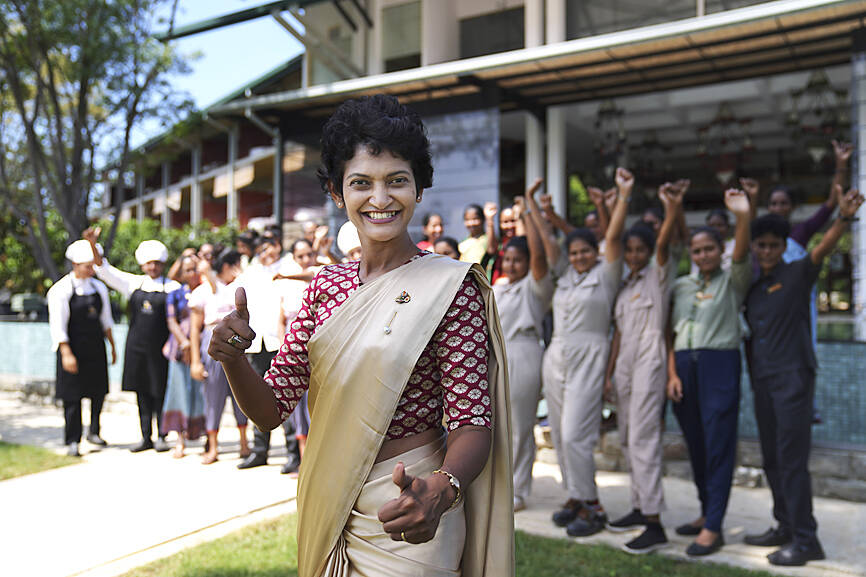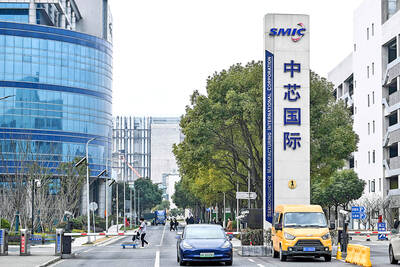After leaving school, Jeewanthi Adikari was determined to pursue her studies in accounting, but her life took a different path when she began a three-month training program in hospitality.
She has since worked in hotels throughout a career spanning more than two decades. Now 42, she is in charge of Sri Lanka’s first resort fully operated and managed by women. It is an attempt to address gender disparities in a male-dominated tourism sector.
“This is a place where women can realize their potential. They will not be inside the shell. Instead, they will come out and try to perform better,” said Adikari, who oversees the daily operations of Amba Yaalu, a resort in Dambulla city that serves as a gateway to most of Sri Lanka’s tourist attractions.

Photo: AP
Most Sri Lankan women do not get a chance to work in the tourism industry, earn money and own a career. In a country where 52 percent of the 22 million people are women, they account for only about 10 percent of the 200,000-strong workforce in the hospitality sector.
About 160km northeast of Colombo, the resort is nestled in a mango plantation and all work is managed by 75 women staff who garden, work in the kitchens, clean the facility, address the guests and provide security in the form of seven ex-military members. The resort’s facilities also include training programs for women to develop their skills in hospitality.
The resort opened in January and has been seen as a move unlocking women’s potential and driving the tourism economy in the debt-stricken nation.
The idea was conceived by seasoned hotelier Chandra Wickramasinghe, who said he was “inspired by the power of women,” especially that of his mother, who raised him and his seven siblings as a single parent.
“I knew what these ladies can do. I got the idea and put my team to work on it. We got a strong team to run it and it worked very well,” Wickramasinghe said, adding that the resort would enable women to thrive as leaders.
Social stigma, language barriers, work-life balance, lack of training facilities and low salaries have long kept the majority of Sri Lankan women away from the hospitality industry, especially those in the rural areas, said Suranga Silva, professor of tourism economics in the University of Colombo.
“Tourism industry can’t be isolated from women,” Silva said, adding that women’s employment in Sri Lanka’s tourism is low compared with the global and regional levels.
Sri Lanka’s tourism and hospitality sector contributed 2.3 percent to the country’s economy in 2023 — down from 5 percent in 2018 — and the industry has traditionally been the country’s third-largest foreign exchange earner.
Kaushalya Batagoda, the executive chef at the resort, said the industry faces a shortage of female professionals to serve in the kitchen and as a result, most staff recruited to the resort’s kitchen were rookies still in training.
However, “the new generation has a passion for working in the kitchen,” Batagoda said, adding that she gets a lot of applications from women.
The resort has been lauded by women’s rights advocates who have long been concerned about limited career choices for women in Sri Lanka.
Rights advocate Sepali Kottegoda said that such business enterprises can “open up more safe employment opportunities for women.”
Silva said that “a dramatic change” is taking place as more young women are eager to join the industry, but suggested that the government and the sector must jointly provide training programs for women to improve their skills and employability.
At Amba Yaalu resort, some of these concerns are already being tackled.
“This is purely to empower women,” Adikari said. “We invite women to come and join us, see whether they can perform better in the career, sharpen their capacities and skills and contribute to the industry.”

NO BREAKTHROUGH? More substantial ‘deliverables,’ such as tariff reductions, would likely be saved for a meeting between Trump and Xi later this year, a trade expert said China launched two probes targeting the US semiconductor sector on Saturday ahead of talks between the two nations in Spain this week on trade, national security and the ownership of social media platform TikTok. China’s Ministry of Commerce announced an anti-dumping investigation into certain analog integrated circuits (ICs) imported from the US. The investigation is to target some commodity interface ICs and gate driver ICs, which are commonly made by US companies such as Texas Instruments Inc and ON Semiconductor Corp. The ministry also announced an anti-discrimination probe into US measures against China’s chip sector. US measures such as export curbs and tariffs

The US on Friday penalized two Chinese firms that acquired US chipmaking equipment for China’s top chipmaker, Semiconductor Manufacturing International Corp (SMIC, 中芯國際), including them among 32 entities that were added to the US Department of Commerce’s restricted trade list, a US government posting showed. Twenty-three of the 32 are in China. GMC Semiconductor Technology (Wuxi) Co (吉姆西半導體科技) and Jicun Semiconductor Technology (Shanghai) Co (吉存半導體科技) were placed on the list, formally known as the Entity List, for acquiring equipment for SMIC Northern Integrated Circuit Manufacturing (Beijing) Corp (中芯北方積體電路) and Semiconductor Manufacturing International (Beijing) Corp (中芯北京), the US Federal Register posting said. The

India’s ban of online money-based games could drive addicts to unregulated apps and offshore platforms that pose new financial and social risks, fantasy-sports gaming experts say. Indian Prime Minister Narendra Modi’s government banned real-money online games late last month, citing financial losses and addiction, leading to a shutdown of many apps offering paid fantasy cricket, rummy and poker games. “Many will move to offshore platforms, because of the addictive nature — they will find alternate means to get that dopamine hit,” said Viren Hemrajani, a Mumbai-based fantasy cricket analyst. “It [also] leads to fraud and scams, because everything is now

MORTGAGE WORRIES: About 34% of respondents to a survey said they would approach multiple lenders to pay for a home, while 29.2% said they would ask family for help New housing projects in Taiwan’s six special municipalities, as well as Hsinchu city and county, are projected to total NT$710.65 billion (US$23.61 billion) in the upcoming fall sales season, a record 30 percent decrease from a year earlier, as tighter mortgage rules prompt developers to pull back, property listing platform 591.com (591新建案) said yesterday. The number of projects has also fallen to 312, a more than 20 percent decrease year-on-year, underscoring weakening sentiment and momentum amid lingering policy and financing headwinds. New Taipei City and Taoyuan bucked the downturn in project value, while Taipei, Hsinchu city and county, Taichung, Tainan and Kaohsiung